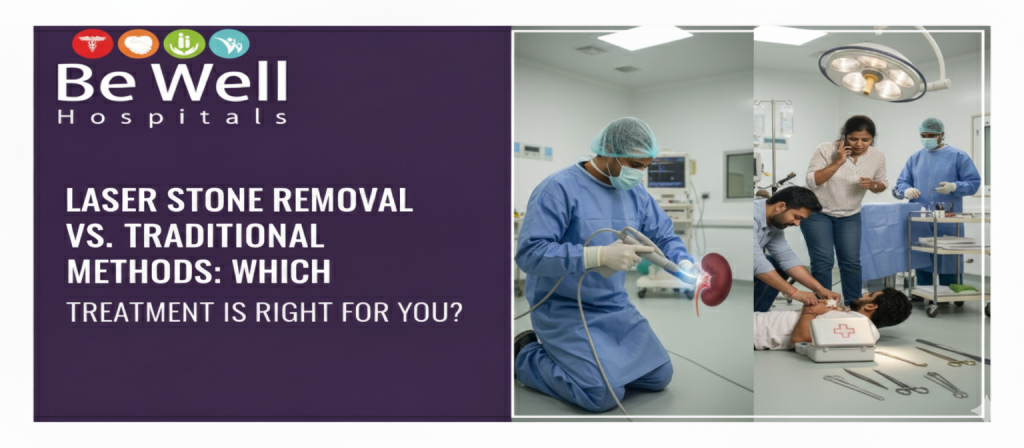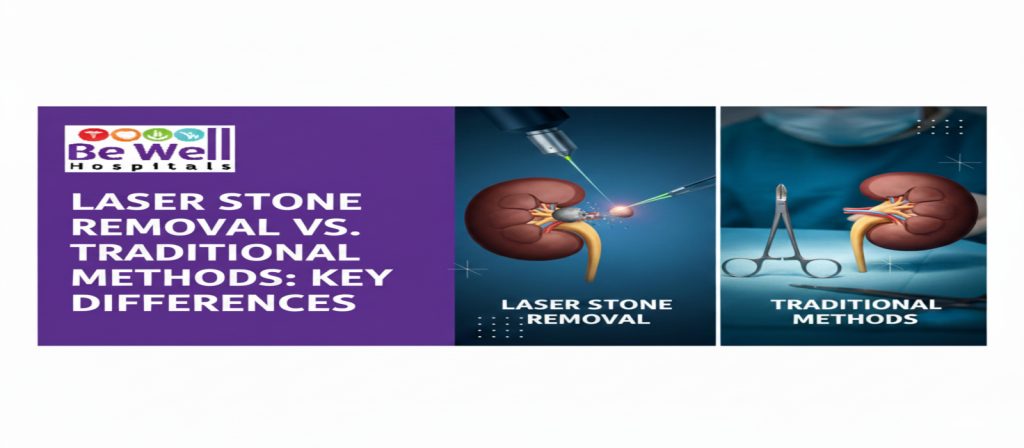
Introduction
Kidney stones are a painful and common condition that can severely affect daily life, often requiring medical intervention for relief. Over the years, treatment options have evolved, ranging from traditional methods like open surgery and shock wave lithotripsy to modern techniques such as laser stone removal. With technology advancing rapidly, patients today have more choices than ever. But which treatment truly works best?
In this blog, we’ll compare laser stone removal with traditional methods, examining how each works, their pros and cons, recovery times, and overall effectiveness. Whether you are dealing with your first kidney stone or looking for better solutions after past treatments, this guide will help you make an informed decision.
What Are Kidney Stones?
Kidney stones are solid deposits made of minerals and salts that form inside the kidneys when substances in the urine—such as calcium, oxalate, or uric acid—become too concentrated. They can range from tiny grains to large stones that block the urinary tract, causing intense pain. Some common causes of kidney stones include:
- Dehydration and reduced urine output
- Diets high in salt, protein, or oxalate-rich foods like spinach and nuts
- Obesity or sedentary lifestyle
- Certain health conditions such as urinary tract infections or hyperparathyroidism
- Family history of kidney stones
Kidney Stone Symptoms
Recognizing symptoms early is crucial for timely treatment. Common signs include:
- Sharp pain in the back, side, or abdomen that radiates to the groin
- Painful or uncomfortable sensation while urinating
- Frequent urge to urinate, often with little urine output
- Pink, red, or brown-colored urine, indicating blood in the urine
- Cloudy or foul-smelling urine, often suggesting infection
- Nausea and vomiting triggered by irritation or severe pain
- Fever and chills that occur when infection is present with stones
- Reduced urine flow due to blockage caused by larger stones
If these symptoms occur—especially severe pain or fever—immediate medical attention is necessary.
Traditional Kidney Stone Treatments
Before advanced laser methods, patients relied primarily on shock wave lithotripsy (SWL) and open surgery.
- Shock Wave Lithotripsy (SWL): Uses external shock waves to break stones into smaller pieces that pass naturally. Effective for smaller stones but less successful for large or dense stones, and may require multiple sessions.
- Open Surgery: Once the standard treatment, open surgery involves directly removing the stone through an incision. While effective, it is invasive, painful, and requires longer recovery times.
These treatments still play a role today but are increasingly being replaced by minimally invasive methods.
What Is Laser Stone Removal?
Laser stone removal, also called laser lithotripsy, uses a thin ureteroscope inserted through the urinary tract to locate the stone. A high-powered laser then breaks the stone into fine particles, which are either removed or pass naturally through urine. It’s gaining popularity because it is minimally invasive and highly precise, effective for all stone types and sizes, allows same-day or short hospital stays, and ensures quick recovery with minimal discomfort.
Laser Stone Removal vs. Traditional Methods: Key Differences

1. Precision
- Laser: Directly targets stones without harming nearby tissues.
- Traditional: SWL may affect surrounding tissue; surgery is invasive.
2. Effectiveness
- Laser: Works for all stone sizes and types, even hard-to-reach areas.
- Traditional: Less effective for large or complex stones.
3. Invasiveness
- Laser: Minimally invasive through natural urinary pathways.
- Traditional: Surgery is highly invasive; SWL is non-invasive but less targeted.
4. Recovery Time
- Laser: Quick recovery; many patients discharged same or next day.
- Traditional: Longer downtime, especially after surgery.
5. Clearance Rate
- Laser: High success in a single procedure.
- Traditional: Multiple SWL sessions often required.
6. Post-Procedure Pain
- Laser: Less discomfort due to minimal tissue damage.
- Traditional: More pain and risk of complications.
7. Hospital Stay
- Laser: Outpatient or short admission.
- Traditional: Prolonged stay after surgery.
8. Risk of Complications
- Laser: Lower risk of infection, bleeding, or tissue damage.
- Traditional: Higher risks, especially in open procedures.
9. Suitability
- Laser: Ideal for most patients, including elderly or complex cases.
- Traditional: Less suited for high-risk patients.
Can Kidney Stones Be Prevented?
While treatment options are effective, prevention is always better. Making small lifestyle changes can greatly lower your risk:
- Stay hydrated by drinking 2–3 liters of water daily.
- Reduce salt intake, as high sodium raises calcium in urine.
- Balance calcium by eating calcium-rich foods but avoiding excessive supplements.
- Limit oxalate-rich foods such as spinach, beets, nuts, and chocolate.
- Reduce animal protein, since too much red meat or shellfish increases uric acid.
- Maintain a healthy weight, as obesity is linked to kidney stone risk.
- Regular checkups are important to monitor kidney health, especially if you have a history of stones.
Choosing the Right Treatment for Long-Term Relief
Both traditional methods and laser stone removal have their place in urology. Shock wave lithotripsy may be suitable for smaller stones, and surgery is still considered in rare cases. However, laser stone removal has become the gold standard due to its precision, minimal invasiveness, faster recovery, and high success rate. Your treatment choice should depend on the stone’s size, type, and location, your overall health and medical history, the availability of advanced technology, and your specialist’s recommendations.Consulting a urologist ensures the right diagnosis and a personalized treatment plan.
Conclusion
Kidney stones can be debilitating, but modern treatment options provide effective relief. While traditional methods like shock wave lithotripsy and open surgery have long been used, laser stone removal stands out as the most advanced, efficient, and patient-friendly option. With faster recovery, fewer complications, and higher success rates, it is increasingly becoming the preferred choice in modern urology. By combining medical expertise with preventive lifestyle changes, you can manage and even reduce your risk of kidney stones.
If you are experiencing kidney stone symptoms or considering treatment, schedule a consultation with our specialists today. Visit our Nephrology Department or call 9698 300 300 to book your appointment and take the first step toward effective relief.
